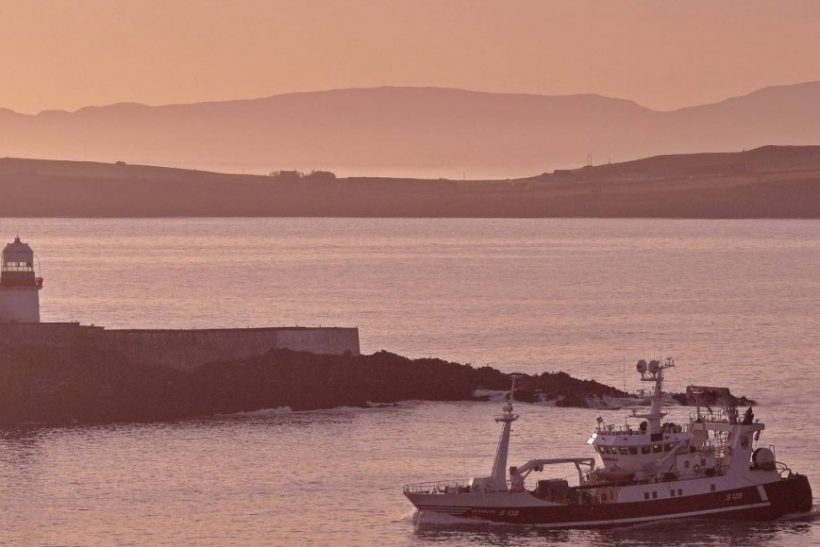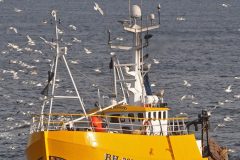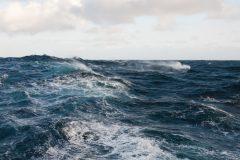KILLYBEGS LEADS THE WAY IN IRELAND
Its location in one of Europe’s outstanding natural harbours, adjacent to major fishing grounds in the North Atlantic, means that Killybegs is synonymous with the fishing industry. David Linkie reports.
Generations of continual re-investment in the future of the fishing industry, as shown by the well-matched and integrated combination of modern vessels and pelagic fish processing factories, means that, in addition to being the biggest fishing centre in Ireland, with an average annual catch value in excess of €110m from around 180,000t, Killybegs is also a main player in the European fishing sector. Pelagic fish processed in the small Co Donegal town, which has a population of under 2,000, is exported and consumed globally.
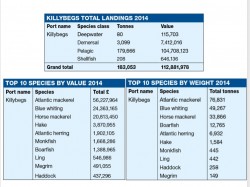
Killybegs landing figures
Given the prominent role Killybegs has in the Irish fishing industry, it is not surprising that the town is home to a number of well known companies, including boat builders, net makers, deck machinery specialists and electronics suppliers, several of which were present at the 2016 Skipper Expo in Galway.
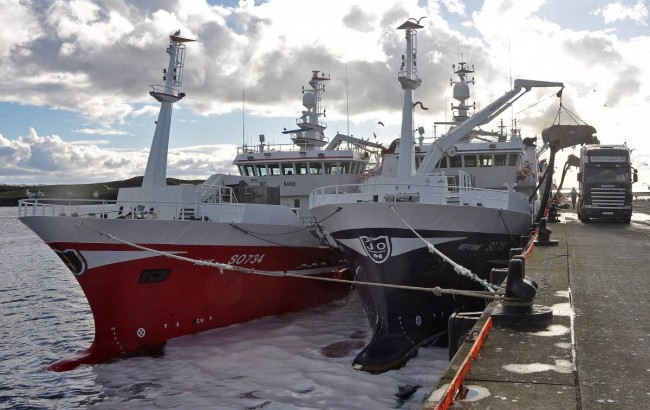
Neptune discharging mackerel while berthed on the New Pier inside her pair-trawling partner Aine.
PELAGIC FISHERIES RUNNING LATER THAN USUAL IN KILLYBEGS
Killybegs has experienced a slower than usual start to this year, with the main midwater fisheries on which the local community are heavily reliant – mackerel, scad and boarfish – said to be running some three weeks later than normal.
Apart from a rapid succession of Atlantic storms, that brought 100-knot winds and extremely heavy seas, and frequently brought fishing to an abrupt halt throughout January, the main reason for the off-on-off start is thought to be a significant difference in seawater temperatures, particularly in relation to mackerel.
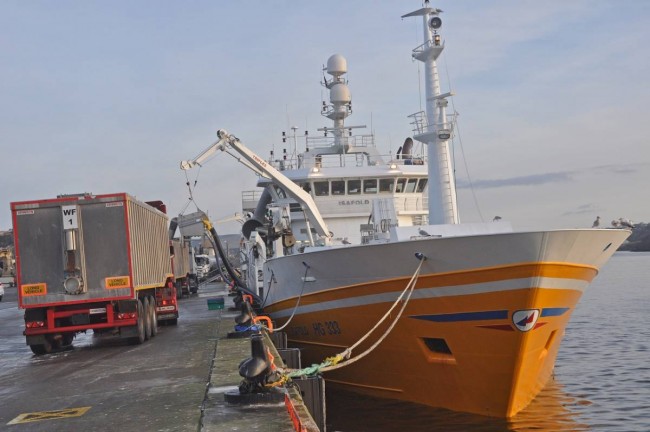
The Danish pelagic vessel Isafold landing at the New Pier.
While the main marks of mackerel were located in the vicinity of Rona, over 300 miles north of Killybegs, in January, the fish hung around this area for considerably longer than usual, showing a marked reluctance to start following their customary migratory route into the south-west along the edge of the deepwater towards their spawning grounds in the Bay of Biscay.
While some Killybegs midwater trawlers steamed up The Minch, when conditions permitted, before heading west out past the Butt of Lewis, others took the long game option and decided to retain their mackerel quota until the main runs of fish were considerably closer to Co Donegal.
This did not happen until just two weeks ago, when, having slowly made their way down to St Kilda, the main run of mackerel then quickly gathered momentum to move rapidly into the south-south-west, swimming up to 45 miles a day.
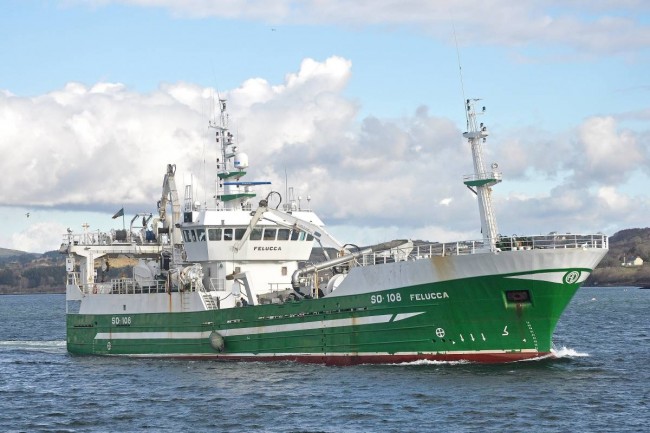
Felucca departs Killybegs for the mackerel grounds, before buckling up with her midwater pair-trawling partner vessel Genesis II.
As is frequently the case, however, skippers found that potential catching difficulties were overshadowed by real-time issues. The high densities of mackerel on the grounds, with some skippers reporting steaming over extremely heavy marks up to 6.5 miles long and 2.9 miles wide, resulted in a number of boats reporting blowing bags, and related extensive gear damage, even though no trawls were shot before daylight and short tows were the order of the day, when skippers generally tried to just skiff the edge of a mark.
Still, every cloud is said to have a silver lining, and the problems encountered while fishing ensured a never-ending succession of work for netmaking companies.
Throughout the mackerel season, the quality of fish has again been extremely high, with local processors reported to be paying around €700-€800 per tonne.
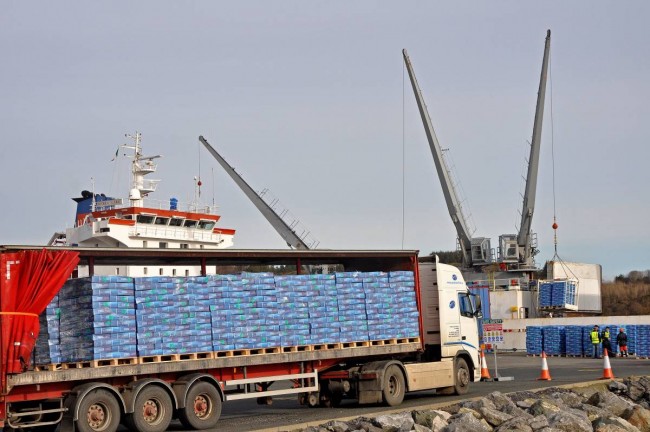
Cartons of frozen mackerel being loaded onto the Dutch reefer ship Sierra Lara for export.
Home to a number of some of the most modern pelagic processing in Europe, including Arctic Fish Sales, Donegal Fish, Gallagher Brothers, Island Seafoods, Killybegs Seafoods, Norfish, Premier Fish and Sean Ward, Killybegs can collectively handle some 2000t of pelagic species during typically intensive but relatively short periods of peak seasonal fishing activity.
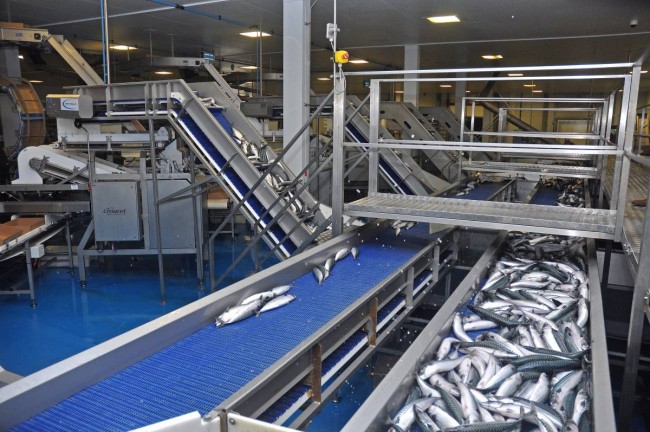
Killybegs is home to one of the biggest concentrations of privately-owned modern pelagic processing companies in Europe.
Providing around 300 jobs in a town with a population of just 1,200 highlights the important socio-economic role fish processing has in the local community. It also highlights the achievements of local processors, who continually compete in international markets alongside some big players.
Doing so successfully has required processors in Killybegs to invest substantially in state-of-the-art grading, packaging, freezing, and cold storage facilities. The associated level of commitment, both financial and in terms of the all-important sales orders, of course, requires regular access to raw product.
This is reflected by the fact that in the first six weeks of this year, a number of visiting midwater trawlers from Shetland, north-east Scotland and Denmark, including Serene, Chris Andra, Challenge, Gitte Henning and Isafold, landed mackerel into Killybegs, which is one of the busiest pelagic ports in Europe.
Including several Burtonport and Greencastle-owned boats, the local Killybegs midwater fleet consists of some 20 single/pair trawlers. Most of these are between 40m and 64m LOA, and include such vessels as Atlantic Challenge, Atlantic II, Brendelen, Father McKee, Felucca, Genesis II, Neptune, Paula, Sheanne, Vigilant, Western Endeavour and the new Western Viking.
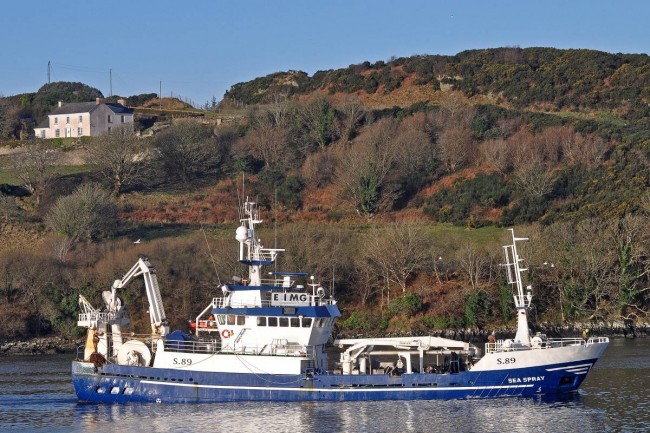
Sea Spray returns to Killybegs after pair-trawling for mackerel with Menhaden.
The arrival last year of the three new Killybegs-owned 27.35 sisterships Carmarose, Colmcille and Westward Isle, highlights the extent to which Co Donegal owners continue their well-proven track record of reinvesting in the pelagic sector. This policy will be continued next year with the arrival of a new Aine, which will be very similar to the 56.3m Western Viking that Karstensen Shipyard delivered to skipper Enda Doherty and Premier Trawlers six months ago.
Traditionally, early-year pelagic activity also attracts a similar number of, mainly smaller, polyvalent pair-trawlers to Killybegs, from other ports on the west coast of Ireland, such as Castletownbere, Dingle, and Rossaveal. Examples from this sector of Ireland’s midwater fleet include Buddy M, Carmona, Cisemair, Eilean Croine, Fiona K II, Guiding Star II, Glor Na Dtonn, Lövön, Ocean Venture II, Oilean An Óir and Sparkling Star.
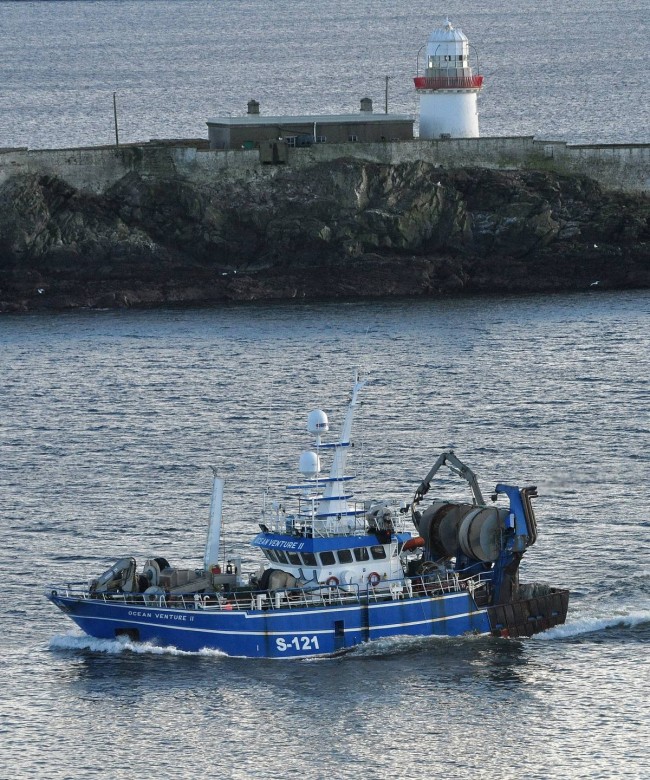
The polyvalent vessel Ocean Venture II heads in to Killybegs after pair-trawling with Fiona K II.
Clearly, being able to provide skippers with fast turnaround times, while offering prices equivalent to those on offer at other landing centres, together with sheltered deepwater berthing, contribute to Killybegs’ ability to attract landings from a large fleet of local and visiting midwater vessels, of which up to 30 can be in harbour at times.
The subsequent arrival of larger reefer ships, the berthing requirements of which are comfortably met by the extensive new pier, before typically around 6,000t of frozen pelagic fish are loaded for export, bring furtherwelcome local employment opportunities, as well as another stream of revenue for Killybegs harbour.
Further evidence of the ability of local processing factories to compete on an international stage is expected to be seen in coming weeks, when the larger class of Norwegian and Scottish midwater trawlers usually land blue whiting directly into Killybegs for the human consumption market, during a busy six-week period directly following the mackerel season.
Before it came to a close towards the end of February, the winter scad (horse mackerel) fishery proved to be a challenging one for Killybegs-based vessels. Although processors were paying €800-€1000 for scad, the fish was generally difficult to catch. One of the reasons for this was said to be the fleet of large international midwater freezer trawlers, the constant presence of which on the grounds west of Co Donegal, south to Achill Island and Co Mayo, fragmented the marks and led to longer trips.
The vitally important role fishing plays in Killybegs is vividly illustrated by the fact that 77% of annual turnover generated in the community comes from capture fisheries (27%), fish processing (36%), and the ancillary service sector (12.5%). In terms of employment, the same three sectors provide 800 of the 1,200 jobs available in Killybegs.
The inherent balance between catching and processing ability, that has been carefully nurtured and grown over a long period of time in Killybegs, was fully apparent towards the end of last month, when the quays were a constant hive of activity from 08.00hrs, with a succession of midwater trawlers landing fish directly to processors in a well-co-ordinated and effectively managed fashion.
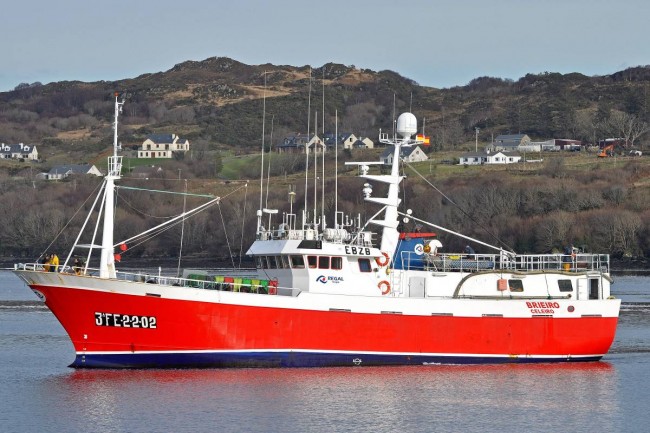
Brieiro is one of a number of Spanish longliners that regularly fish from Killybegs.
Balance is one of the key features and strengths of Killybegs. Displayed in a number of different ways, including target species, vessel type and landing facilities, balance, in turn, brings valuable diversity of fishing effort, processing capability and marketing diversity to the local industry.
This well-meshed combination was fully apparent two weeks ago, when mackerel, scad and boarfish were being landed at the same time, during one of the busiest periods of activity seen at Killybegs this year.
Completion in 2004 of the security-accessed New Pier, following a €50m construction programme, doubled the previous quay frontage available on the existing Town and Black Rock Piers. The project created 450m of quayside berthing (-12m CD), together with a modern shiplift, indoor vessel maintenance hall (which attracts vessels from all over Ireland for annual maintenance work), and an extensive adjacent area covering 16,000m2, suitable for stretching out several large mid-water trawls to facilitate and ease gear repairs. The array of quayside berths available in three discreet areas of the harbour, thereby avoiding possible congestion, is such that, at times, up to 15 midwater vessels across the full-size spectrum were landing simultaneously.
A variety of Spanish and Anglo-Spanish longliners, netters and trawlers are also frequent visitors to Killybegs, where catches are, in the main, landed directly into refrigerated lorries for transport to Spain.
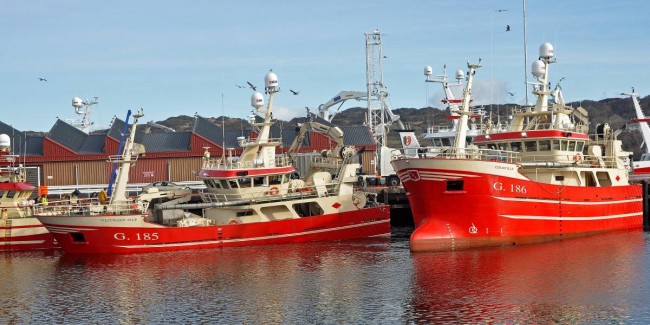
Westward Isle moves inside Colmcille to land at the Town Pier.
CONTINUING CHALLENGES AHEAD
KFO Chief Executive Officer Sean O’Donoghue
The need for clarity and practicality with regard to all aspects of international fisheries management, together with a level playing field for all the countries involved, was highlighted as being of crucial importance by Sean O’Donoghue, chief executive officer of Killybegs Fishermen’s Organisation (KFO), while speaking to Fishing News in his office overlooking Killybegs harbour.
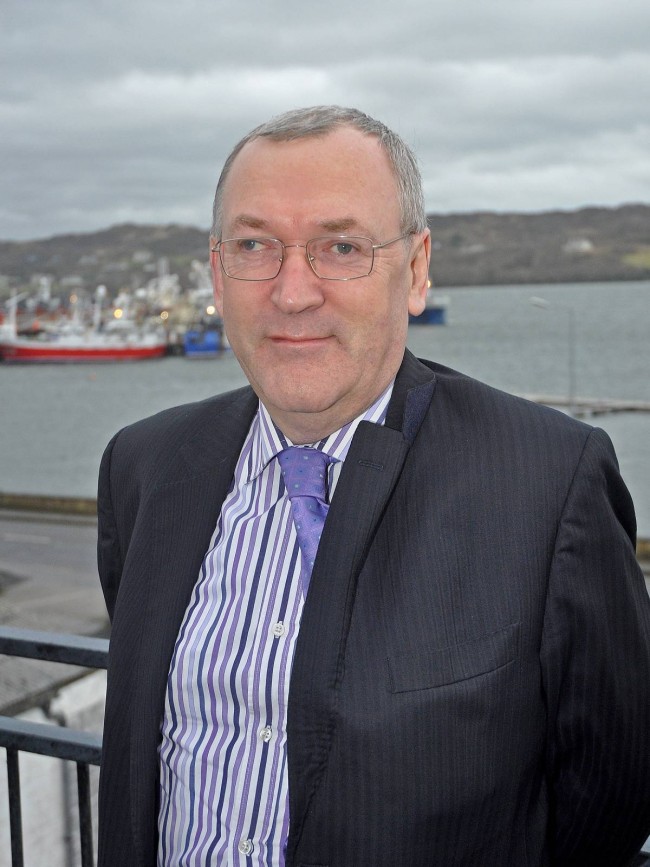
With Killybegs midwater trawlers expected to start fishing blue whiting in the next two weeks, Sean O’Donoghue expressed grave concerns about the current situation, which sees Norway working off a significantly higher TAC than Ireland and other EU countries, as a result of the bilateral deal on blue whiting put in place by the European Commission and Norway last December, which outraged the pelagic industry.
Although the EU has a higher percentage share of the lower EU TAC than was previously the case, Ireland has 24,000t of blue whiting to catch this year and there is marked uncertainty about how the current two-tier situation will be resolved going forward.
Sean O’Donoghue said: “At a time when the Irish fleet, together with its counterparts in Denmark, France, Holland and Scotland, has just been awarded MSC-certification for the blue whiting fishery, it is extremely difficult to understand the logic of the current arrangement. Having recently met Commissioner Vella, with other pelagic EU industry representatives, on this issue, I am hopeful that it is only temporary for 2016, and that the Commission is fully committed to finding a long-term solution.”
KFO members are also extremely disappointed with regard to the current situation of a zero TAC for herring having been set in ICES Area VI north and south, despite the fact that Minister Coveney assured the Irish industry at the December Fisheries Council that a review of this disappointing outcome was expected by the end of February, and that a small TAC would be set for the remainder of the year. Industry concern is heightened by the large quantities of herring repeatedly seen on the grounds.
The decision to implement a zero TAC for both areas arose out of the failure of the ICES benchmark in February 2015 to separate the two stocks. Recognising this as a major issue, the KFO, in conjunction with its Scottish and Dutch counterparts, is organising a major genetic survey of herring stocks in Area VI, which is hoped will be successful in providing a mechanism for separation. This work will be carried out along similar lines to the genetic scientific research conducted by UCD Dr Ed Farrell, funded by KFO, on boarfish stocks in Area VII over the past two years.
In the next few months, Ireland’s pelagic sector will participate in the important triannual mackerel egg survey, which, having started on February 1, has been extended to continue until August. In 2015, the Killybegs midwater trawler, Atlantic Challenge, took part in the pre-egg survey. A review of this disappointing outcome was expected at the end of February, with the KFO pushing hard for a small TAC to be set for the remainder of this year.
Two months after the demersal landing obligation came into force for haddock in Area VI and the Irish Sea, whiting in the Celtic Sea, together with Nephrops and hake in all three areas, and limited Dover sole, Sean O’Donoghue stressed the paramount importance of concentrating all efforts on avoidance and minimalisation of discards, coupled with incentives, during the next two years, before adding any further species.
Sean O’Donoghue stated: “The risk that traditional sustainable fisheries, on which whitefish boats continue to rely heavily, could be closed by choke species is already well documented. Despite this widespread industry concern, no measures have yet been put forward to address this problem. The philosophy is clearly flawed, as, if fisheries are closed in this way, it will defeat the whole purpose of the discard ban.
“Attention continues to be firmly focused on Article 15 of the Common Fisheries Policy – the demersal landing obligation requirement – rather than Article 14 on avoidance and minimalisation measures.
“In the next two years the industry needs to go as far as possible with new measures, but if these are not enough, then there is a clear need to look at some changes to the landing obligation requirement, in order to ensure that whitefish vessels can continue to fish.”
Sean O’Donoghue also expressed disappointment at the current delay of 18 months in starting construction of a world-class marine food ingredients plant in Killybegs, which is designed to utilise quantities of blue whiting and boarfish. Bio-Marine Ingredients Ireland Ltd is a joint venture between local Killybegs stakeholders and the Norwegian company Biomarine Science Technology.
Although the state-of-the-art facility would be located on the designated fish industry site in Killybegs, An Taisce has lodged an objection, which is under consideration by An Bord Planala.
With the capacity to process some 50,000t of pelagic fish a year, while creating 65 to 70 jobs when in full production, in addition to around 50 jobs during the construction period, the facility would represent a huge boost for Killybegs.
FORWARD MOVING KT NETS
Moving into considerably bigger premises just outside Killybegs, two years ago, has enabled the dedicated midwater trawl company KT Nets to continue to expand and develop an enhanced service facility for existing and new clients.
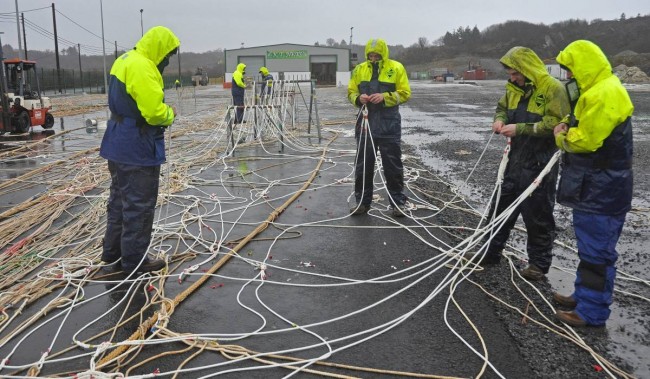
Staff at KT Nets repair a midwater trawl outside the company’s extensive new premises just outside Killybegs.
Specialising in the design and manufacture of pelagic fishing gear, KT Nets was established in 2003 by three local netmakers, Danny Gallagher, Donald John Maclean and Anthony Breslin. Working from its previous premises in Dunkineely, KT Nets quickly earned a solid reputation for providing the best quality products, with guaranteed reliability, backed up with a high level of personal service.
This enabled KT nets to build up a strong customer base, stretching from Shetland to Co Cork and beyond.
Several skippers from Killybegs and elsewhere have recently taken delivery of new midwater nets ranging from 420m to 1638m circumference. KT Nets is currently constructing 1177m and 1280m m/w trawls and 80-metre braillers specially designed to fish most species, including mackerel, scad, herring, blue whiting and boarfish.
Mostly featuring standard 25.6m meshes in the wings, the midwater trawls are constructed primarily throughout from Enkalon nylon, supplied by Van Beelen, and fitted with standard braillers, some of which incorporate T90 mesh and eight panels.
Father McKee, Sheanne, Antartic, Vigilant, Brendelen, Veronica, Voyager, Stefanie M, Havilah, Sparkling Star, Eilean Croine, Carmona, Lovon, Seaspray, Menhaden, Dillon Owen, Buddy M, Star of Hope, Serene, Unity, Christina S and Adenia are some of the boats that use midwater gear supplied by KT Trawls.
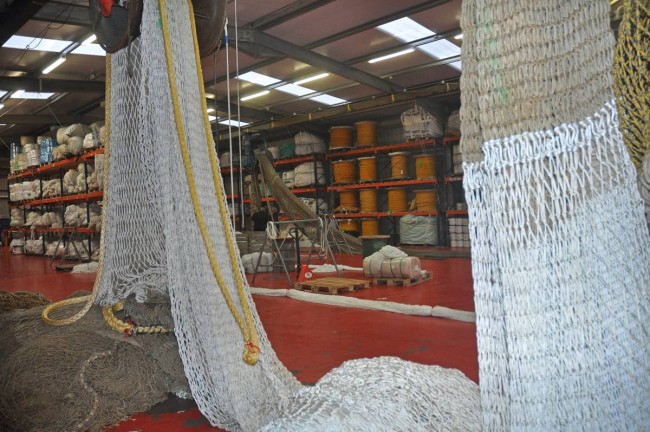
Renewing braillers in the expansive and well-stocked net hall of KT Nets.
The exceptionally large marks of mackerel experienced since the start of this year, which, although relatively easy to locate, proved extremely difficult to catch in sufficiently small quantities to avoid the sudden weight of fish causing extensive damage to gear, ensured that the team at KT Nets was constantly working flat-out to repair damaged gear before boats returned to the grounds.
Watch out for part two of our Killybegs port profile in Fishing News tomorrow


KILLYBEGS LEADS THE WAY IN IRELAND Its location in one of Europe’s outstanding natural harbours, adjacent to major fishing grounds in the North Atlantic, means that Killybegs is synonymous with the fishing industry. David Linkie reports. Generations of continual re-investment in the future of the fishing industry, as shown by the well-matched and integrated combination of modern vessels and pelagic fish processing factories, means that, in addition to being the biggest fishing centre in Ireland, with an average annual catch value in excess of €110m from around 180,000t, Killybegs is also a main player in the European fishing sector. Pelagic fish processed in the small Co Donegal town, which has a population of under 2,000, is exported and consumed globally.

Killybegs landing figures
Given the prominent role Killybegs has in the Irish fishing industry, it is not surprising that the town is home to a number of well known companies, including boat builders, net makers, deck machinery specialists and electronics suppliers, several of which were present at the 2016 Skipper Expo in Galway.

Neptune discharging mackerel while berthed on the New Pier inside her pair-trawling partner Aine.
PELAGIC FISHERIES RUNNING LATER THAN USUAL IN KILLYBEGS Killybegs has experienced a slower than usual start to this year, with the main midwater fisheries on which the local community are heavily reliant – mackerel, scad and boarfish – said to be running some three weeks later than normal. Apart from a rapid succession of Atlantic storms, that brought 100-knot winds and extremely heavy seas, and frequently brought fishing to an abrupt halt throughout January, the main reason for the off-on-off start is thought to be a significant difference in seawater temperatures, particularly in relation to mackerel.

The Danish pelagic vessel Isafold landing at the New Pier.
While the main marks of mackerel were located in the vicinity of Rona, over 300 miles north of Killybegs, in January, the fish hung around this area for considerably longer than usual, showing a marked reluctance to start following their customary migratory route into the south-west along the edge of the deepwater towards their spawning grounds in the Bay of Biscay. While some Killybegs midwater trawlers steamed up The Minch, when conditions permitted, before heading west out past the Butt of Lewis, others took the long game option and decided to retain their mackerel quota until the main runs of fish were considerably closer to Co Donegal. This did not happen until just two weeks ago, when, having slowly made their way down to St Kilda, the main run of mackerel then quickly gathered momentum to move rapidly into the south-south-west, swimming up to 45 miles a day.

Felucca departs Killybegs for the mackerel grounds, before buckling up with her midwater pair-trawling partner vessel Genesis II.
As is frequently the case, however, skippers found that potential catching difficulties were overshadowed by real-time issues. The high densities of mackerel on the grounds, with some skippers reporting steaming over extremely heavy marks up to 6.5 miles long and 2.9 miles wide, resulted in a number of boats reporting blowing bags, and related extensive gear damage, even though no trawls were shot before daylight and short tows were the order of the day, when skippers generally tried to just skiff the edge of a mark. Still, every cloud is said to have a silver lining, and the problems encountered while fishing ensured a never-ending succession of work for netmaking companies. Throughout the mackerel season, the quality of fish has again been extremely high, with local processors reported to be paying around €700-€800 per tonne.

Cartons of frozen mackerel being loaded onto the Dutch reefer ship Sierra Lara for export.
Home to a number of some of the most modern pelagic processing in Europe, including Arctic Fish Sales, Donegal Fish, Gallagher Brothers, Island Seafoods, Killybegs Seafoods, Norfish, Premier Fish and Sean Ward, Killybegs can collectively handle some 2000t of pelagic species during typically intensive but relatively short periods of peak seasonal fishing activity.

Killybegs is home to one of the biggest concentrations of privately-owned modern pelagic processing companies in Europe.
Providing around 300 jobs in a town with a population of just 1,200 highlights the important socio-economic role fish processing has in the local community. It also highlights the achievements of local processors, who continually compete in international markets alongside some big players. Doing so successfully has required processors in Killybegs to invest substantially in state-of-the-art grading, packaging, freezing, and cold storage facilities. The associated level of commitment, both financial and in terms of the all-important sales orders, of course, requires regular access to raw product. This is reflected by the fact that in the first six weeks of this year, a number of visiting midwater trawlers from Shetland, north-east Scotland and Denmark, including Serene, Chris Andra, Challenge, Gitte Henning and Isafold, landed mackerel into Killybegs, which is one of the busiest pelagic ports in Europe. Including several Burtonport and Greencastle-owned boats, the local Killybegs midwater fleet consists of some 20 single/pair trawlers. Most of these are between 40m and 64m LOA, and include such vessels as Atlantic Challenge, Atlantic II, Brendelen, Father McKee, Felucca, Genesis II, Neptune, Paula, Sheanne, Vigilant, Western Endeavour and the new Western Viking.

Sea Spray returns to Killybegs after pair-trawling for mackerel with Menhaden.
The arrival last year of the three new Killybegs-owned 27.35 sisterships Carmarose, Colmcille and Westward Isle, highlights the extent to which Co Donegal owners continue their well-proven track record of reinvesting in the pelagic sector. This policy will be continued next year with the arrival of a new Aine, which will be very similar to the 56.3m Western Viking that Karstensen Shipyard delivered to skipper Enda Doherty and Premier Trawlers six months ago. Traditionally, early-year pelagic activity also attracts a similar number of, mainly smaller, polyvalent pair-trawlers to Killybegs, from other ports on the west coast of Ireland, such as Castletownbere, Dingle, and Rossaveal. Examples from this sector of Ireland’s midwater fleet include Buddy M, Carmona, Cisemair, Eilean Croine, Fiona K II, Guiding Star II, Glor Na Dtonn, Lövön, Ocean Venture II, Oilean An Óir and Sparkling Star.

The polyvalent vessel Ocean Venture II heads in to Killybegs after pair-trawling with Fiona K II.
Clearly, being able to provide skippers with fast turnaround times, while offering prices equivalent to those on offer at other landing centres, together with sheltered deepwater berthing, contribute to Killybegs’ ability to attract landings from a large fleet of local and visiting midwater vessels, of which up to 30 can be in harbour at times. The subsequent arrival of larger reefer ships, the berthing requirements of which are comfortably met by the extensive new pier, before typically around 6,000t of frozen pelagic fish are loaded for export, bring furtherwelcome local employment opportunities, as well as another stream of revenue for Killybegs harbour. Further evidence of the ability of local processing factories to compete on an international stage is expected to be seen in coming weeks, when the larger class of Norwegian and Scottish midwater trawlers usually land blue whiting directly into Killybegs for the human consumption market, during a busy six-week period directly following the mackerel season. Before it came to a close towards the end of February, the winter scad (horse mackerel) fishery proved to be a challenging one for Killybegs-based vessels. Although processors were paying €800-€1000 for scad, the fish was generally difficult to catch. One of the reasons for this was said to be the fleet of large international midwater freezer trawlers, the constant presence of which on the grounds west of Co Donegal, south to Achill Island and Co Mayo, fragmented the marks and led to longer trips. The vitally important role fishing plays in Killybegs is vividly illustrated by the fact that 77% of annual turnover generated in the community comes from capture fisheries (27%), fish processing (36%), and the ancillary service sector (12.5%). In terms of employment, the same three sectors provide 800 of the 1,200 jobs available in Killybegs. The inherent balance between catching and processing ability, that has been carefully nurtured and grown over a long period of time in Killybegs, was fully apparent towards the end of last month, when the quays were a constant hive of activity from 08.00hrs, with a succession of midwater trawlers landing fish directly to processors in a well-co-ordinated and effectively managed fashion.

Brieiro is one of a number of Spanish longliners that regularly fish from Killybegs.
Balance is one of the key features and strengths of Killybegs. Displayed in a number of different ways, including target species, vessel type and landing facilities, balance, in turn, brings valuable diversity of fishing effort, processing capability and marketing diversity to the local industry. This well-meshed combination was fully apparent two weeks ago, when mackerel, scad and boarfish were being landed at the same time, during one of the busiest periods of activity seen at Killybegs this year. Completion in 2004 of the security-accessed New Pier, following a €50m construction programme, doubled the previous quay frontage available on the existing Town and Black Rock Piers. The project created 450m of quayside berthing (-12m CD), together with a modern shiplift, indoor vessel maintenance hall (which attracts vessels from all over Ireland for annual maintenance work), and an extensive adjacent area covering 16,000m2, suitable for stretching out several large mid-water trawls to facilitate and ease gear repairs. The array of quayside berths available in three discreet areas of the harbour, thereby avoiding possible congestion, is such that, at times, up to 15 midwater vessels across the full-size spectrum were landing simultaneously. A variety of Spanish and Anglo-Spanish longliners, netters and trawlers are also frequent visitors to Killybegs, where catches are, in the main, landed directly into refrigerated lorries for transport to Spain.

Westward Isle moves inside Colmcille to land at the Town Pier.
CONTINUING CHALLENGES AHEAD KFO Chief Executive Officer Sean O’Donoghue The need for clarity and practicality with regard to all aspects of international fisheries management, together with a level playing field for all the countries involved, was highlighted as being of crucial importance by Sean O’Donoghue, chief executive officer of Killybegs Fishermen’s Organisation (KFO), while speaking to Fishing News in his office overlooking Killybegs harbour.  With Killybegs midwater trawlers expected to start fishing blue whiting in the next two weeks, Sean O’Donoghue expressed grave concerns about the current situation, which sees Norway working off a significantly higher TAC than Ireland and other EU countries, as a result of the bilateral deal on blue whiting put in place by the European Commission and Norway last December, which outraged the pelagic industry. Although the EU has a higher percentage share of the lower EU TAC than was previously the case, Ireland has 24,000t of blue whiting to catch this year and there is marked uncertainty about how the current two-tier situation will be resolved going forward. Sean O’Donoghue said: “At a time when the Irish fleet, together with its counterparts in Denmark, France, Holland and Scotland, has just been awarded MSC-certification for the blue whiting fishery, it is extremely difficult to understand the logic of the current arrangement. Having recently met Commissioner Vella, with other pelagic EU industry representatives, on this issue, I am hopeful that it is only temporary for 2016, and that the Commission is fully committed to finding a long-term solution.” KFO members are also extremely disappointed with regard to the current situation of a zero TAC for herring having been set in ICES Area VI north and south, despite the fact that Minister Coveney assured the Irish industry at the December Fisheries Council that a review of this disappointing outcome was expected by the end of February, and that a small TAC would be set for the remainder of the year. Industry concern is heightened by the large quantities of herring repeatedly seen on the grounds. The decision to implement a zero TAC for both areas arose out of the failure of the ICES benchmark in February 2015 to separate the two stocks. Recognising this as a major issue, the KFO, in conjunction with its Scottish and Dutch counterparts, is organising a major genetic survey of herring stocks in Area VI, which is hoped will be successful in providing a mechanism for separation. This work will be carried out along similar lines to the genetic scientific research conducted by UCD Dr Ed Farrell, funded by KFO, on boarfish stocks in Area VII over the past two years. In the next few months, Ireland’s pelagic sector will participate in the important triannual mackerel egg survey, which, having started on February 1, has been extended to continue until August. In 2015, the Killybegs midwater trawler, Atlantic Challenge, took part in the pre-egg survey. A review of this disappointing outcome was expected at the end of February, with the KFO pushing hard for a small TAC to be set for the remainder of this year. Two months after the demersal landing obligation came into force for haddock in Area VI and the Irish Sea, whiting in the Celtic Sea, together with Nephrops and hake in all three areas, and limited Dover sole, Sean O’Donoghue stressed the paramount importance of concentrating all efforts on avoidance and minimalisation of discards, coupled with incentives, during the next two years, before adding any further species. Sean O’Donoghue stated: “The risk that traditional sustainable fisheries, on which whitefish boats continue to rely heavily, could be closed by choke species is already well documented. Despite this widespread industry concern, no measures have yet been put forward to address this problem. The philosophy is clearly flawed, as, if fisheries are closed in this way, it will defeat the whole purpose of the discard ban. “Attention continues to be firmly focused on Article 15 of the Common Fisheries Policy – the demersal landing obligation requirement – rather than Article 14 on avoidance and minimalisation measures. “In the next two years the industry needs to go as far as possible with new measures, but if these are not enough, then there is a clear need to look at some changes to the landing obligation requirement, in order to ensure that whitefish vessels can continue to fish.” Sean O’Donoghue also expressed disappointment at the current delay of 18 months in starting construction of a world-class marine food ingredients plant in Killybegs, which is designed to utilise quantities of blue whiting and boarfish. Bio-Marine Ingredients Ireland Ltd is a joint venture between local Killybegs stakeholders and the Norwegian company Biomarine Science Technology. Although the state-of-the-art facility would be located on the designated fish industry site in Killybegs, An Taisce has lodged an objection, which is under consideration by An Bord Planala. With the capacity to process some 50,000t of pelagic fish a year, while creating 65 to 70 jobs when in full production, in addition to around 50 jobs during the construction period, the facility would represent a huge boost for Killybegs.
With Killybegs midwater trawlers expected to start fishing blue whiting in the next two weeks, Sean O’Donoghue expressed grave concerns about the current situation, which sees Norway working off a significantly higher TAC than Ireland and other EU countries, as a result of the bilateral deal on blue whiting put in place by the European Commission and Norway last December, which outraged the pelagic industry. Although the EU has a higher percentage share of the lower EU TAC than was previously the case, Ireland has 24,000t of blue whiting to catch this year and there is marked uncertainty about how the current two-tier situation will be resolved going forward. Sean O’Donoghue said: “At a time when the Irish fleet, together with its counterparts in Denmark, France, Holland and Scotland, has just been awarded MSC-certification for the blue whiting fishery, it is extremely difficult to understand the logic of the current arrangement. Having recently met Commissioner Vella, with other pelagic EU industry representatives, on this issue, I am hopeful that it is only temporary for 2016, and that the Commission is fully committed to finding a long-term solution.” KFO members are also extremely disappointed with regard to the current situation of a zero TAC for herring having been set in ICES Area VI north and south, despite the fact that Minister Coveney assured the Irish industry at the December Fisheries Council that a review of this disappointing outcome was expected by the end of February, and that a small TAC would be set for the remainder of the year. Industry concern is heightened by the large quantities of herring repeatedly seen on the grounds. The decision to implement a zero TAC for both areas arose out of the failure of the ICES benchmark in February 2015 to separate the two stocks. Recognising this as a major issue, the KFO, in conjunction with its Scottish and Dutch counterparts, is organising a major genetic survey of herring stocks in Area VI, which is hoped will be successful in providing a mechanism for separation. This work will be carried out along similar lines to the genetic scientific research conducted by UCD Dr Ed Farrell, funded by KFO, on boarfish stocks in Area VII over the past two years. In the next few months, Ireland’s pelagic sector will participate in the important triannual mackerel egg survey, which, having started on February 1, has been extended to continue until August. In 2015, the Killybegs midwater trawler, Atlantic Challenge, took part in the pre-egg survey. A review of this disappointing outcome was expected at the end of February, with the KFO pushing hard for a small TAC to be set for the remainder of this year. Two months after the demersal landing obligation came into force for haddock in Area VI and the Irish Sea, whiting in the Celtic Sea, together with Nephrops and hake in all three areas, and limited Dover sole, Sean O’Donoghue stressed the paramount importance of concentrating all efforts on avoidance and minimalisation of discards, coupled with incentives, during the next two years, before adding any further species. Sean O’Donoghue stated: “The risk that traditional sustainable fisheries, on which whitefish boats continue to rely heavily, could be closed by choke species is already well documented. Despite this widespread industry concern, no measures have yet been put forward to address this problem. The philosophy is clearly flawed, as, if fisheries are closed in this way, it will defeat the whole purpose of the discard ban. “Attention continues to be firmly focused on Article 15 of the Common Fisheries Policy – the demersal landing obligation requirement – rather than Article 14 on avoidance and minimalisation measures. “In the next two years the industry needs to go as far as possible with new measures, but if these are not enough, then there is a clear need to look at some changes to the landing obligation requirement, in order to ensure that whitefish vessels can continue to fish.” Sean O’Donoghue also expressed disappointment at the current delay of 18 months in starting construction of a world-class marine food ingredients plant in Killybegs, which is designed to utilise quantities of blue whiting and boarfish. Bio-Marine Ingredients Ireland Ltd is a joint venture between local Killybegs stakeholders and the Norwegian company Biomarine Science Technology. Although the state-of-the-art facility would be located on the designated fish industry site in Killybegs, An Taisce has lodged an objection, which is under consideration by An Bord Planala. With the capacity to process some 50,000t of pelagic fish a year, while creating 65 to 70 jobs when in full production, in addition to around 50 jobs during the construction period, the facility would represent a huge boost for Killybegs.
FORWARD MOVING KT NETS Moving into considerably bigger premises just outside Killybegs, two years ago, has enabled the dedicated midwater trawl company KT Nets to continue to expand and develop an enhanced service facility for existing and new clients.

Staff at KT Nets repair a midwater trawl outside the company’s extensive new premises just outside Killybegs.
Specialising in the design and manufacture of pelagic fishing gear, KT Nets was established in 2003 by three local netmakers, Danny Gallagher, Donald John Maclean and Anthony Breslin. Working from its previous premises in Dunkineely, KT Nets quickly earned a solid reputation for providing the best quality products, with guaranteed reliability, backed up with a high level of personal service. This enabled KT nets to build up a strong customer base, stretching from Shetland to Co Cork and beyond. Several skippers from Killybegs and elsewhere have recently taken delivery of new midwater nets ranging from 420m to 1638m circumference. KT Nets is currently constructing 1177m and 1280m m/w trawls and 80-metre braillers specially designed to fish most species, including mackerel, scad, herring, blue whiting and boarfish. Mostly featuring standard 25.6m meshes in the wings, the midwater trawls are constructed primarily throughout from Enkalon nylon, supplied by Van Beelen, and fitted with standard braillers, some of which incorporate T90 mesh and eight panels. Father McKee, Sheanne, Antartic, Vigilant, Brendelen, Veronica, Voyager, Stefanie M, Havilah, Sparkling Star, Eilean Croine, Carmona, Lovon, Seaspray, Menhaden, Dillon Owen, Buddy M, Star of Hope, Serene, Unity, Christina S and Adenia are some of the boats that use midwater gear supplied by KT Trawls.

Renewing braillers in the expansive and well-stocked net hall of KT Nets.
The exceptionally large marks of mackerel experienced since the start of this year, which, although relatively easy to locate, proved extremely difficult to catch in sufficiently small quantities to avoid the sudden weight of fish causing extensive damage to gear, ensured that the team at KT Nets was constantly working flat-out to repair damaged gear before boats returned to the grounds.
Watch out for part two of our Killybegs port profile in Fishing News tomorrow

